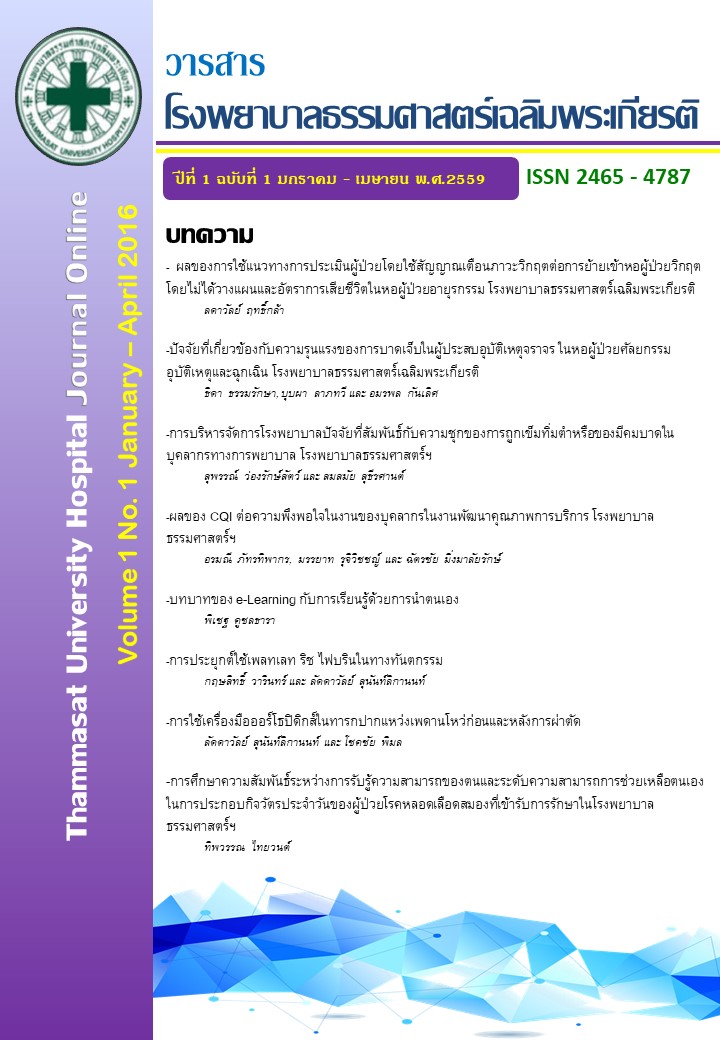Factors related to Severity of injuried in patients with traffic accidents at Trauma and Emergency Ward, Thammasat University Hospital
Keywords:
Severity of Injury, Injured from Traffic Accident, Thammasat University HospitalAbstract
The purposes of this study were to study factors related to severity of injured from traffic accidents at Trauma and Emergency Ward, Thammasat University Hospital (TUH). The sample was 150 injured who were admitted in the period of May to August 2014. And they were selected by specific random sampling. Data was collected by using questionnaire, and records of severity of injuries. And the data were analyzed by using frequency, percentage and chi square test.
The results revealed that the most of injured sample was male (68.7%), aged between 15 - 40 years (65.4 %) and they were drivers (52.0%). The cause of injured was hit or collision with other vehicle (47.3%). Motorcycle was used for transport frequently (51.4 %). The characteristic of wound was Blunt trauma (62.0 %). The vehicles ran at the speed 40 – 60 Kilometers per hour (38.0%), and the accidental time was mostly at 6:00 a.m. – 12:00 p.m. (31.3%). The majority of injured did not take alcohol drinking (66.0 %), and they did not use Personal Protective Equipments: PPE (helmet and safety belt) during driving or transport (58.0%). And during driving, they did not use medicine with side effect on the nervous system (78.0%). The severity of injury was at mild level mostly (38.0%).
The factors related to the severity of injured from traffic accidents statistically (p ≤ 0.05) were the speed of vehicle, alcohol drinking, PPE (helmet and safety belt) using and the usage of medicine with side effect on the nervous system. Whereas the other factors related to the severity of injured statistically insignificant (P > 0.05), including gender, age, injured category, the cause of injury, vehicle classification, wound characteristics and accidental time.
The findings of this study can be utilized as a guideline for prevention and reduce the effects of the traffic accident severity through campaign and detecting traffic violator with high speed driving, alcohol drinking, no PPE (helmet and safety belt) and the usage of medicine with side effect on the nervous system during driving.
References
กุหลาบทิพย์ พิทักษ์รัตนานุกูล. (2552). สาเหตุของการบาดเจ็บของผู้ที่เข้ารับการรักษาที่ห้องฉุกเฉินโรงพยาบาลลำพูน. ปริญญาสาธารณสุขศาสตรมหาบัณฑิต. บัณฑิตวิทยาลัยมหาวิทยาลัยเชียงใหม่.
ชัชวาล จันทะเพชร. (2552). การศึกษาลักษณะของผู้ป่วยที่ได้รับบาดเจ็บจากอุบัติเหตุทางจราจร. วารสารเวชศาสตร์ฉุกเฉินไทย.ฉบับที่ 2 เมษายน – มิถุนายน.
นิติวัฒน์ รัตนานิคม, และชนานุช ดิษฐเนตร. (2538).การศึกษาการบาดเจ็บจากอุบัติเหตุจราจรของโรงพยาบาลสกลนคร ระหว่างเทศกาลสงกรานต์. ขอนแก่นเวชสาร, ปีที่ 20 (1), มกราคม – เมษายน, 2539.
บุษบา เพ็ญสุวรรณ. (2539). ปัจจัยที่เกี่ยวข้องกับความรุนแรงของการบาดเจ็บจากอุบัติเหตุจราจรทางบกของผู้ป่วยใน ณ.โรงพยาบาลร้อยเอ็ด. ปริญญาวิทยาศาสตรมหาบัณฑิต จุฬาลงกรณ์
ประภาศรี ทองด้วง. (2550 – 2551). ระดับของแอลกอฮอล์และความรุนแรงของการบาดเจ็บในผู้ป่วยอุบัติเหตุจราจรทางบกที่มารับบริการรักษาในโรงพยาบาลโนนสูง จังหวัดนครราชสีมา. ปริญญาสาธารณสุขศาสตรมหาบัณฑิต มหาวิทยาลัยขอนแก่น.
เรืองศิริ ไกรคง. (2549). การศึกษาความรุนแรงของการบาดเจ็บจากอุบัติเหตุจราจรที่มารับการรักษาในโรงพยาบาลวัดโบสถ์ จังหวัดพิษณุโลก.
สุวิมล ว่องวาณิช, และนงลักษณ์ วิรัชชัย. (2546). แนวทางการให้คำปรึกษาวิทยานิพนธ์.กรุงเทพมหานคร: ศูนย์ตาราและเอกสารทางวิชาการคณะครุศาสตร์จุฬาลงกรณ์มหาวิทยาลัย.
สมศิริ พันธุ์ศักดิ์ศิริ. (2545). ความรุนแรงของการบาดเจ็บจากอุบัติเหตุจราจร ศึกษาในโรงพยาบาลสระบุรี. วิทยานิพนธ์มหาบัณฑิต วิทยาศาสตร์บัณฑิต (ชีวสถิติ).
สำนักระบาดวิทยา กรมควบคุมโรค. (2548 – 2553). รายงานสถานการณ์การบาดเจ็บรุนแรงและเสียชีวิตจากสาเหตุภายนอก.
Champion HR., Sacco WJ, Copes WS., GamnDS,Gennarelli TA., & Flanagan ME. (1989). A revision of the trauma score. J Trauma, 29, 623-629.
Revell M., Pynsent P., Abudu A., & Fairbank J. (2003). Trauma score and trauma outcome measures. J Trauma, 5(1), 67-70.


